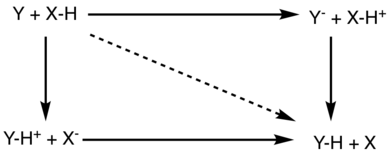Proton-coupled electron transfer
A Proton-coupled electron transfer (PCET) is a chemical reaction that involves the transfer of electrons and protons. The term was originally coined for single proton, single electron processes that are concerted,[1] but the definition has relaxed to include many related processes. Reactions that involve the concerted shift of a single electron and a single proton are often called Concerted Proton-Electron Transfer or CPET.[2]
In PCET, the proton and the electron (i) start from different orbitals and (ii) are transferred to different atomic orbitals. They transfer in a concerted elementary step. CPET contrast to step-wise mechanisms in which the electron and proton are transferred sequentially.
- ET
- [HX] + [M] → [HX]+ + [M]−
- PT
- [HX] + [M] → [X]− + [HM]+
- CPET
- [HX] + [M] → [X] + [HM]
Examples
PCET is thought to be pervasive in redox reactions that appear to be net hydrogenations and dehydrogenations. Relevant examples include water oxidation in photosynthesis, nitrogen fixation and oxygen reduction in many pathways for respiration. Inorganic chemists often study simple reactions to test this mechanism, one example being the comproportionation of a Ru(II) aquo and a Ru(IV) oxo reactants: cis-[(bipy)2(py)RuIV(O)]2+ + cis-[(bipy)2(py)RuII(OH2)]2+ → 2cis-[(bipy)2(py)RuIII(OH)]2+ PCET is also often invoked in electrochemical reactions where reduction is coupled to protonation or where oxidation is coupled to deprotonation.[3]

Although it is relatively simple to demonstrate that the electron and proton begin and end in different orbitals, it is more difficult to prove that they do not move sequentially. General sequential pathways are higher in energy than concerted pathways. The main evidence that PCET exists is that a number of reactions occur faster than expected for the sequential pathways. In the initial electron transfer (ET) mechanism, the initial redox event has a minimum thermodynamics barrier associate with the first step. Similarly, the initial proton transfer (PT) mechanism has a minimum barrier associated with the protons initial pKa. Variations on these minimum barriers are also considered. The important finding is that there are a number of reactions with rates greater than these minimum barriers would permit. This suggests a third mechanism lower in energy; the concerted PCET has been offered as this third mechanism. This assertion has also been supported by the observation of unusually large kinetic isotope effects (KIE).
A typical method for establishing PCET pathway is to show that the individual ET and PT pathways operate at higher activation energy than the concerted pathway.[2]
In some literature, the definition of PCET has been extended to include the sequential mechanisms listed above. This confusion in the definition of PCET has led to the proposal of alternate names including electron transfer-proton transfer (ETPT), electron-proton transfer (EPT), and concerted proton-electron transfer (CPET).
Also distinct is hydrogen atom transfer (HAT), in which the proton and electron start in the same orbitals and move together to the final orbital. HAT is recognized as a radical pathway, although the stoichiometry is similar to that for PCET.
References
1.Weinberg, D. R.; Gagliardi, C. J.; Hull, J. F.; Murphy, C. F.; Kent, C. A.; Westlake, B.; Paul, A.; Ess, D. H.; McCafferty, D. G; Meyer, T. J. Proton Coupled Electron Transfer. Chem. Rev. 2012, 112, 4016-4093. DOI: 10.1021/cr200177j
- Huynh, My Hang V.; Meyer, Thomas J. (2007). "Proton-Coupled Electron Transfer". Chemical Reviews. 107 (11): 5004–5064. doi:10.1021/cr0500030. PMC 3449329. PMID 17999556.
- Warren, J. J.; Tronic, T. A.; Mayer, J. M. (2010). "Thermochemistry of Proton-Coupled Electron Transfer Reagents and Its Implications". Chemical Reviews. 110: 6961–7001. doi:10.1021/cr100085k. PMC 3006073. PMID 20925411.
- Costentin, Cyrille; Marc Robert; Jean-Michel Savéant (2010). "Concerted Proton−Electron Transfers: Electrochemical and Related Approaches". Accounts of Chemical Research. 43 (7): 1019–1029. doi:10.1021/ar9002812. PMID 20232879.